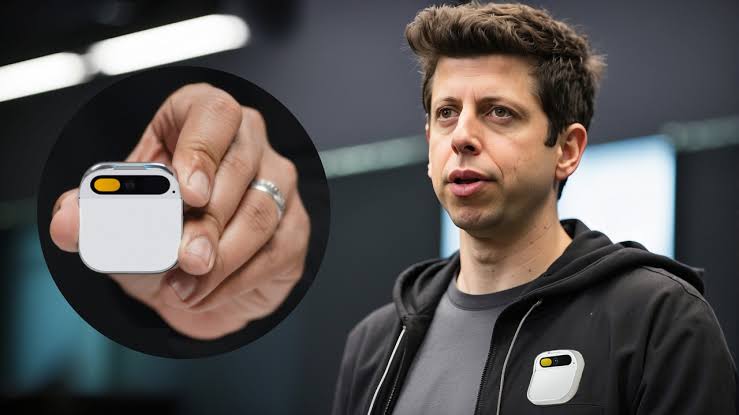OpenAI’s Game-Changing AI Companion: The Revolutionary Screenless Device Shaping the Future”

OpenAI AI device Next Big Bet: A Compact, Screenless AI Companion Device
OpenAI has undeniably reshaped the landscape of artificial intelligence, leading the way with its powerful language models and groundbreaking technologies. Now, the company is setting its sights on a new, ambitious project that could once again change the way we interact with AI. According to a report from The Wall Street Journal, OpenAI is working on a new device that is completely different from anything the company has introduced before. While the world has come to expect wearables or even AI-powered glasses, OpenAI’s next major product will be a compact, screenless device designed to be fully aware of its surroundings.
This move comes on the heels of OpenAI’s recent acquisition of io, a startup co-founded by former Apple designer Jony Ive, in a deal worth a staggering $6.5 billion. The acquisition is expected to significantly shape the direction of OpenAI’s future products, especially this new AI device, which will reportedly serve as a “third core device” in users’ everyday lives—complementing existing gadgets like the MacBook Pro and iPhone.
What Is OpenAI’s New Device?
Sam Altman, the CEO of OpenAI AI device, revealed during a meeting with employees that the new product will not be a wearable, but instead a small, portable, screenless device. The device will be designed to sit on a desk or fit into your pocket. In essence, it’s an “AI companion” that will integrate seamlessly into users’ daily lives.
One of the most intriguing aspects of the device is its ability to be “fully aware” of its environment. This means that the device will be able to interact with its surroundings, potentially opening up new possibilities for context-aware applications, from smart home automation to personalized assistance based on the user’s location, activities, and needs.
Altman compared the device to existing core gadgets such as the MacBook Pro and iPhone. However, rather than just another smartphone or wearable, this device is being positioned as something that will become an essential part of users’ day-to-day routines. It will act as a kind of “third core device,” occupying a unique place between your phone and laptop while offering a more intimate, seamless connection with AI.
Why Is This Such a Big Deal? OpenAI AI device

OpenAI’s decision to build a compact, screenless device is particularly significant because it represents a shift away from the direction that many tech companies, including Apple, Google, and others, are currently pursuing. Rather than focusing on wearables or augmented reality glasses, OpenAI is looking at a different approach to integrating AI into people’s lives—one that doesn’t require a screen or a wearable form factor.
The acquisition of io and its renowned designer, Jony Ive, is another key piece of the puzzle. Known for his work on iconic Apple products like the iPhone, iMac, and Apple Watch, Ive is expected to bring his design expertise to this new device. The collaboration is likely to result in a product that not only offers cutting-edge AI capabilities but also features an elegant and user-friendly design that appeals to a broad audience.
OpenAI AI device
According to Altman, the new device could eventually add $1 trillion in market value to OpenAI, revolutionizing the way we think about and interact with OpenAI AI device. It will create a new category of devices that is unlike any of the existing products on the market. It’s not just another gadget or accessory—it’s a completely new way to integrate AI into your daily life.
How Will It Be Different from Other AI Devices OpenAI AI device?
While many companies have attempted to introduce AI-powered wearables or smart glasses, OpenAI’s new product will stand apart in several key ways. One of the most striking features of the device is its lack of a screen. While many AI devices rely on visual interfaces to display information or interact with users, OpenAI’s new device will focus on integrating AI into the environment around it. This could mean voice-based interactions, sensory awareness of its surroundings, and perhaps even the ability to assist in tasks like organizing your home, managing your calendar, or suggesting new activities based on your current context.
Another key difference is the device’s portability and size. Unlike bulky wearables or augmented reality glasses, this AI companion will be small enough to sit on a desk or slip into a pocket. Its compact design will make it easy to take with you anywhere, allowing for seamless interaction with AI no matter where you are.
Perhaps most importantly, the device will be able to adapt and learn from its environment. Whether you’re at home, in the office, or out and about, the AI will be able to gather contextual information and provide insights or assistance tailored to the moment. This could make it far more practical and efficient than current AI devices, which often rely on limited or static inputs.
Secrecy and Competition
In the wake of these exciting revelations, Altman emphasized the importance of secrecy surrounding the project. As the device is still in development, OpenAI AI device is working hard to keep its design and capabilities under wraps in order to prevent competitors from copying the idea before it launches. Interestingly, a recording of Altman’s remarks leaked to The Wall Street Journal, sparking discussions about how much he trusts his own team and how forthcoming he will be with further details about the project.
Despite the secrecy, the potential impact of this new device is clear. If successful, it could reshape the market for AI-powered products and set OpenAI apart as a leader in the next generation of technology. By creating a device that blends seamlessly into daily life, OpenAI has the chance to redefine the relationship between humans and AI.
The Future of AI Devices
As we move forward, it’s clear that AI will continue to be a central part of our lives. Whether through advanced language models, intelligent assistants, or innovative new devices, the potential for AI to transform our everyday experiences is limitless. OpenAI’s new product could be the next step in this evolution, creating a new category of AI devices that enhance our lives without requiring us to wear or constantly engage with screens.
While the details are still sparse, it’s clear that OpenAI’s upcoming device will be something entirely different from what we’ve seen before. Whether it lives up to its lofty promises remains to be seen, but if anyone can pull it off, it’s OpenAI. The combination of cutting-edge AI capabilities and Jony Ive’s design expertise could result in a truly revolutionary product.
As the world eagerly awaits more information about this game-changing device, one thing is certain: OpenAI’s vision for the future of AI is about to take a bold new step. Keep an eye on the company’s next moves—this is just the beginning.
#OpenAI #AIDevices #TechInnovation #SamAltman #JonyIve #AIFuture #GenerativeAI #TechNews #OpenAIDevices #AICompanion #TechTrends #AIRevolution











Post Comment